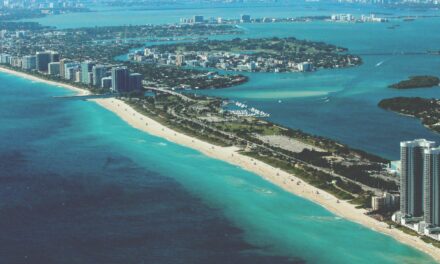In this article, you will learn about the scorching temperatures that Miami experiences. Miami is known for its tropical climate, which means that it gets incredibly hot and humid throughout the year. Whether you are a resident or planning a visit, understanding the extreme heat in Miami is essential.
During the summer months, Miami can reach temperatures of up to 90 degrees Fahrenheit or higher. The combination of the high heat and humidity can make it feel even hotter. It is important to stay hydrated and take necessary precautions to prevent heat-related illnesses. Additionally, you will discover helpful tips on how to stay cool and enjoy your time in Miami, even in the midst of the sweltering heat. So, let’s dive into the details and learn more about how hot it really gets in Miami! Miami, known for its beautiful beaches and vibrant nightlife, is also notorious for its scorching hot temperatures. Located in the southern part of Florida, this city experiences a tropical climate with high levels of humidity throughout the year. In this article, we will explore the average temperatures in Miami, the factors that contribute to its heat, the impact of heat on daily life, measures taken to protect against heat, and future climate projections.
Average Temperature in Miami
Miami experiences relatively warm temperatures throughout the year, thanks to its tropical climate. The city has both a dry season and a wet season, with seasonal variations in temperature and precipitation.
Seasonal Variations
In Miami, the months of December to April are generally considered the dry season, while May to November are considered the wet season. During the dry season, the average high temperatures range from the mid-70s°F (mid-20s°C) to the low 80s°F (high 20s°C). The nights are cooler, with average low temperatures dropping into the mid to high 60s°F (low 20s°C).
On the other hand, during the wet season, Miami experiences higher temperatures and increased humidity. The average high temperatures range from the low to mid-80s°F (high 20s°C), while the average low temperatures range from the high 60s°F (low 20s°C) to the low 70s°F (low 20s°C).
Summer Temperatures
Summer in Miami can be quite intense, with temperatures soaring to uncomfortable levels. During the months of June to August, the average high temperatures climb to the high 80s°F (around 31°C) or even the low 90s°F (around 32°C). The humidity also tends to be high during this time, making it feel even hotter than the actual temperature. It is essential to stay hydrated and protect oneself from the heat during these months.
Winter Temperatures
While winters in Miami are not as cold as in other parts of the country, the temperatures do drop, albeit mildly. From December to February, the average high temperatures range from the low to mid-70s°F (low 20s°C), and the average low temperatures range from the high 50s°F (around 14°C) to the low 60s°F (around 16°C). Although it may not be freezing, the drop in temperature during winter offers a pleasant break from the scorching heat of the summer months.
High Temperature Records
Miami has seen its fair share of extremely high temperatures throughout history. Let’s take a look at the hottest months and notable heatwaves that have occurred in the city.
Hottest Months
The hottest months in Miami are typically July and August, where temperatures can climb to record-breaking highs. It is not uncommon for these months to see average high temperatures in the low 90s°F (around 32°C) and occasional spikes into the mid-90s°F (around 35°C).
Historic Heat Waves
Miami has experienced several historic heatwaves that have tested the endurance of its residents. One such notable heatwave occurred in 1998, when the city experienced a prolonged period of extreme heat. Temperatures soared above 100°F (38°C) for several consecutive days, leaving people scrambling for ways to stay cool and safe.
Factors Influencing Miami’s Heat
Several factors contribute to the intense heat experienced in Miami. Let’s explore some of these factors in more detail.
Geographical Location
Miami’s geographical location plays a significant role in its high temperatures. Situated in southern Florida, the city lies in close proximity to the Tropic of Cancer, which means it receives direct sunlight for most of the year. This direct exposure to the sun’s rays leads to higher temperatures.
Gulf Stream
The Gulf Stream, a warm ocean current, also contributes to Miami’s heat. The warm waters of the Gulf Stream, flowing along the eastern coast of Florida, help maintain high humidity levels and warm air temperatures in the region.
Urban Heat Island Effect
The urban heat island effect is another factor that exacerbates Miami’s heat. The city’s extensive concrete and asphalt surfaces absorb and retain heat, leading to higher temperatures in urban areas compared to surrounding rural areas. The concentration of buildings and infrastructure in the city traps heat, making it feel even hotter.
Impact of Heat on Daily Life in Miami
Miami’s hot temperatures have a significant impact on daily life in the city. Let’s explore some areas where heat plays a crucial role.
Outdoor Activities
The intense heat in Miami can restrict outdoor activities. During the summer months, it is essential to take precautions when engaging in outdoor sports or recreational activities. It is advised to limit activities during the hottest parts of the day, stay hydrated, and seek shade whenever possible.
Energy Consumption
The high temperatures in Miami lead to increased energy consumption, particularly in terms of air conditioning. To combat the heat, residents rely heavily on air conditioning systems, resulting in spikes in electricity usage. It is crucial to use energy-efficient cooling methods and proper insulation to reduce energy consumption and carbon footprint.
Health Risks
The heat in Miami poses health risks, especially for vulnerable populations such as the elderly, children, and individuals with pre-existing medical conditions. Heat-related illnesses such as heat exhaustion and heatstroke can occur if precautions are not taken. It is imperative to stay hydrated, wear appropriate clothing, and seek shelter in air-conditioned spaces to prevent heat-related health issues.
Heat Protection Measures in Miami
To cope with the scorching temperatures, individuals in Miami take various measures to protect themselves from the heat.
Air Conditioning Usage
Air conditioning is a necessity in Miami to combat the intense heat. Most households and establishments have air conditioning systems installed to provide relief from the high temperatures. It is essential to maintain and service these systems regularly to ensure optimal efficiency and minimize energy consumption.
Staying Hydrated
Staying hydrated is critical in Miami’s hot climate. Drinking plenty of water and electrolyte-rich fluids helps prevent dehydration and heat-related illnesses. It is advisable to carry a water bottle and drink regularly throughout the day, even if you do not feel thirsty.
Sun Protection
Protecting oneself from the sun’s rays is crucial when spending time outdoors in Miami. Wearing wide-brimmed hats, applying sunscreen, and wearing sunglasses help shield the skin and eyes from harmful UV radiation. It is also advisable to seek shade whenever possible and wear lightweight, breathable clothing to stay cool.
Heat-Related Events and Initiatives in Miami
Miami recognizes the importance of heat preparedness and takes initiatives to protect its residents from extreme heat events.
Heat Preparedness Programs
The city of Miami has implemented heat preparedness programs to educate residents about the dangers of extreme heat and ways to stay safe. These programs provide information on heat-related illnesses, practical tips for mitigating heat risks, and resources for seeking assistance during heatwaves.
Heat Illness Prevention Campaigns
To raise awareness about the impact of heat on health, Miami organizes heat illness prevention campaigns. These campaigns aim to educate the public, distribute informational materials, and offer resources to vulnerable populations. The goal is to reduce heat-related illnesses and promote heat safety practices.
Forecasting and Monitoring Miami’s Heat
Forecasting and monitoring systems help track and predict the heat patterns in Miami, allowing for timely precautions and effective response to extreme heat events.
Meteorological Data
Meteorological data, including temperature readings, humidity levels, and weather patterns, are continuously monitored to provide accurate and timely information about Miami’s heat. This data helps meteorologists and authorities make informed predictions and issue advisories to the public.
Heat Index
The heat index is a measure that combines temperature and humidity to determine how hot it feels to the human body. Monitoring the heat index helps estimate the level of heat stress and provides valuable information for heat safety planning.
Heat Advisory Systems
Heat advisory systems are in place to alert the public and authorities of potentially dangerous heat conditions. These systems issue heat advisories and warnings, indicating the level of heat risk, and providing recommendations for protective measures. The alerts often include guidance on staying hydrated, seeking cool environments, and minimizing sun exposure.
Comparing Miami’s Heat with Other Cities
Miami is not the only city that experiences extreme heat. Let’s compare Miami’s heat with other cities in the United States and globally.
Hot Cities in the US
Several cities in the United States experience scorching temperatures similar to or higher than Miami. Places like Phoenix, Las Vegas, and Houston are known for their extreme heat, with average daily highs often exceeding 100°F (38°C). However, what sets Miami apart is its high humidity levels, making the heat feel more oppressive.
Global Heat Extremes
On a global scale, many cities in tropical and subtropical regions experience extreme heat. Places such as Dubai, Riyadh, and Bangkok regularly see temperatures reaching well into the 100s°F (40s°C). These cities face unique challenges in dealing with the heat, including high humidity levels and the need for extensive cooling infrastructure.

Future Climate Projections for Miami
Climate change is projected to have significant impacts on Miami’s heat in the coming years. Let’s explore the expected climate change impact and increased heat trends.
Climate Change Impact
Climate change is likely to exacerbate Miami’s already high temperatures. Rising global temperatures and changing weather patterns can lead to more frequent and intense heatwaves. It is essential for residents and the city to adapt and implement strategies to mitigate the effects of climate change and protect against extreme heat events.
Increased Heat Trends
Projections indicate that Miami will experience an overall increase in heat in the future. Average temperatures are expected to rise, leading to more days with extreme heat. This trend emphasizes the importance of heat adaptation measures and climate resilience planning in Miami.
Conclusion
Miami’s heat is no secret, and the city’s residents have learned to adapt and protect themselves from the scorching temperatures. With a tropical climate, high humidity levels, and various geographical factors at play, Miami experiences hot summers and mild winters. It is essential to understand the impact of heat on daily life, take necessary precautions, and work towards long-term solutions to mitigate the effects of increasing heat. By staying informed, adopting heat protection measures, and actively addressing climate change, Miami can continue to thrive while beating the heat.









